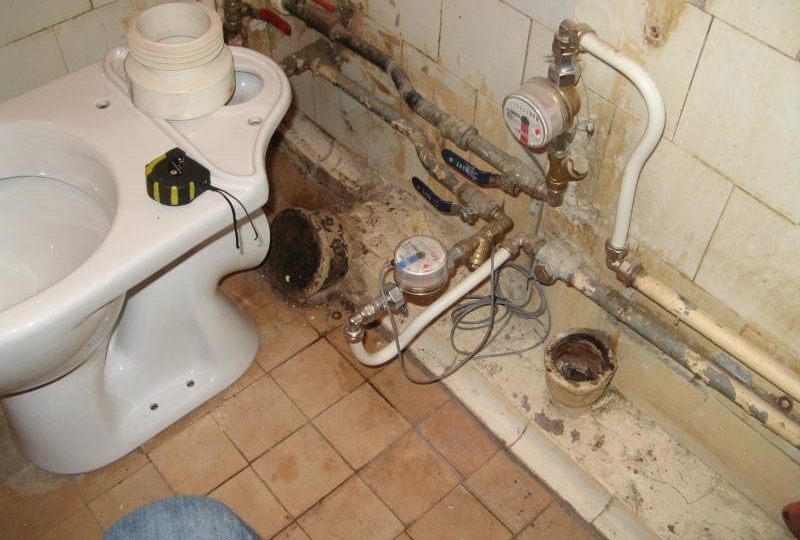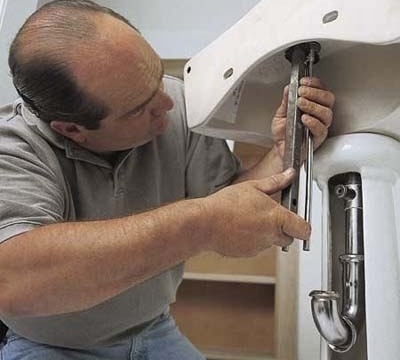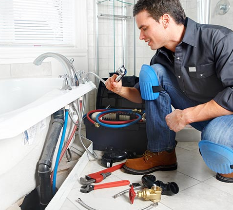How to change the faucet in the kitchen: dismantling the old version and installing the new
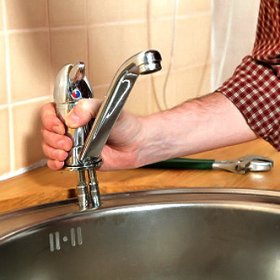
The question of how to change the faucet in the kitchen does not arise as rarely as we would like. For those who think that only a professional plumber can handle this business is good news: independent replacement of the mixer is quite possible. You just need to stock up on a set of simple tools and materials, get acquainted with the device of the kitchen faucet, and also study the recommendations of specialists.
Necessary tools and materials
Most likely, no complicated fixtures for replacing the faucet in the kitchen will be needed. You can cope with the task using:
- adjustable wrench (sometimes it can be successfully replaced with a suitable wrench);
- flat screwdriver;
- Phillips screwdriver;
- Lantern;
- sand paper.
Tip: If the faucet that needs to be replaced was from inexpensive models, it makes sense to change the flexible hoses with which it is attached to the water pipes. Expensive models are equipped with better hoses; at the time of work, they may still be suitable for use. However, there is a risk that the hoses will deteriorate earlier than the new mixer, so in most cases, experts recommend completely replacing these parts.
In addition, you should stock up on a small container in which you can drain the remaining water in the siphon. A detergent may also be useful in order to simultaneously wash away dirt accumulated under the sink and under the mixer while replacing the design. Sealant is used both for washing installation and for threaded connections.
Please note: If the sink is removable rather than mortise, you may have to remove it in order to dismantle the damaged one and it would be more convenient to install a new mixer in the kitchen. In this case, you may also need additional tools, the necessary fasteners, sealant, etc.
So, first you need to purchase a new model, as well as prepare all the necessary tools and materials. Then, armed with a flashlight, you need to look under the sink and get acquainted with the place of work. The whole process can be divided into two stages: dismantling the old mixer and installing a new one.
How to dismantle a broken model?
Dismantling a damaged mixer does not begin in the kitchen, but in the bathroom. First you need to shut off the water so that the kitchen is not flooded.
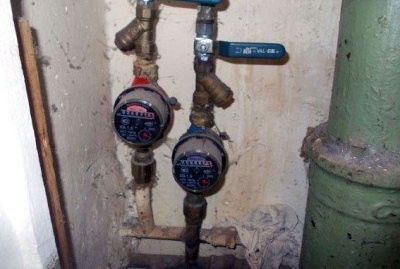
Before dismantling the mixer, turn off the water supply. Handles on faucets must be in a position perpendicular to the water pipe
After that, you can proceed directly to the removal of the damaged mixer. To do this, you need:
1. Open the water tap to drain the remaining water in the system.
2. Find the connection between the flexible hoses of the mixer and the water pipes.
3. Find the place where the mixer is attached to the sink.
4.If the sink is a consignment note, it must be carefully dismantled.
5. Disconnect the flexible hose from the water pipe using an adjustable wrench. At this point, you can use a small container or jar to drain the water remaining in the pipes.
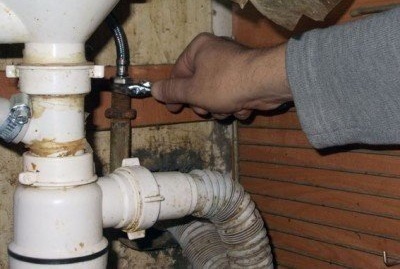
Disconnect the flexible hoses from the water pipe using an adjustable wrench. Be careful not to damage the connection.
6. Disconnect the bottom of the siphon.
7. Now the sink can be removed.
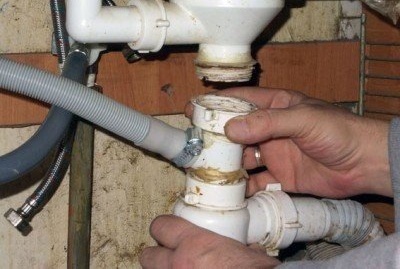
After the lower part of the siphon is disconnected, the sink must be very carefully turned over and set in a position convenient for further work
8. Open the sink in such a way as to allow access to the mixer mounting.
9. Using an adjustable wrench, loosen the nut that is on the threaded pin.
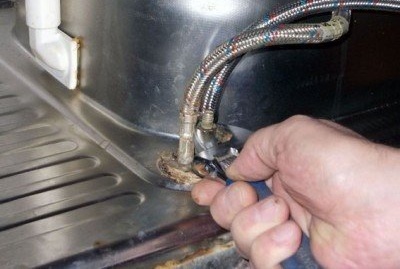
Before you begin unscrewing the threaded pins, you must use an adjustable wrench and loosen the mounting nut on the mixer
10. Now, using a flat or Phillips screwdriver, you need to unscrew the threaded pin itself. To prevent the mixer from falling, it should be held with the bottom of the hand.
11. Remove the clamp and then remove the mixer to which the old flexible hoses are connected.
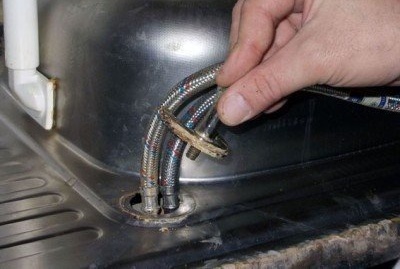
After all fasteners have been removed, carefully remove the mixer. Flexible hoses must be carefully routed through the mounting hole.
Please note: if you decide to leave the old flexible hoses, they must be disconnected from the damaged mixer at this stage (an adjustable wrench will come in handy again). Then the hoses are connected to a new mixer, after which installation is continued. In this case, check the condition of the gaskets of each hose. They must be intact, without signs of deformation and located in the place intended for them.
After the old device is dismantled, you can proceed with the installation of a new mixer. However, before this, it does not hurt to inspect the mounting hole and remove accumulated dirt from it, if any.
Install a new mixer
Before installing the mixer, it is necessary, of course, to assemble and connect the supply elements to the water pipes, i.e. flexible hoses.
After that, you can install a new mixer directly on the sink:
1. The first step is to put an annular gasket on the base of the mixer. It must be exactly in the groove intended for it. If at this stage there are violations, water will leak under the sink and may damage the cabinet, as well as the elements located under the sink.
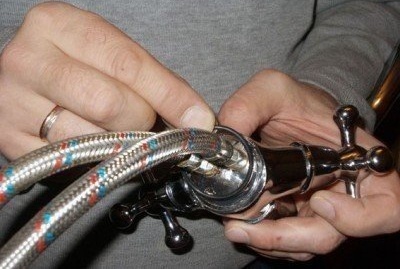
The ring gasket must be placed exactly in the recess intended for it. If this is not done, it is almost impossible to avoid leaks.
2. Now you need to pass the flexible hoses through the mounting hole for the mixer (the removed sink is still in an inverted position). The mixer must again be held from below with your free hand. It is necessary to ensure that the ring gasket does not move at this moment.
3. Install the rubber seal, the shape of which must correspond to the configuration of the pressure plate.
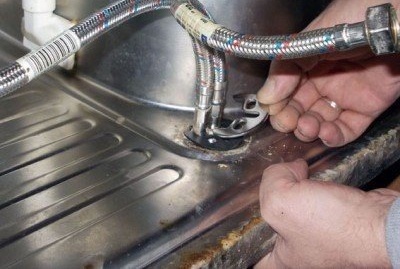
First, a rubber seal is installed, and then a pressure plate, the configuration of which matches. The mixer must be held so that it does not fall.
4. Place a pressure plate on top of the seal.
5. Screw the threaded pins into the structure through the corresponding holes.
Tip: Depending on the device, the mixer may be equipped with one or two threaded pins. It is important to ensure that the slots for the screwdriver remain on the outside and not on the inside of the mixer, as this device will also have to be dismantled once. Usually on new mixers, the threaded pins are screwed in very easily, just with your fingers. You can use a screwdriver, but experts do not recommend tightening them too tightly.
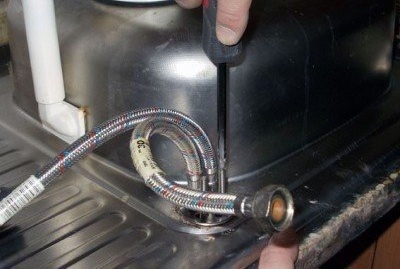
The threaded pins are screwed in freely.They can be tightened with a screwdriver, but not too much. After that, carefully tighten the nut with an adjustable wrench.
6. Now use the adjustable wrench to tighten the mounting nuts. Here additional efforts will be required, because with poorly tightened nuts the mixer will “walk”, rotate around its axis.
Thus, the problem of how to put a new mixer in the kitchen instead of the old one can be considered successfully solved. It remains only to install the dismantled sink in its intended place. Before that, it makes sense to do cleaning: to clean the places where the sink is attached to the wall, the wall itself, the inside of the cabinet, etc. After that, the sink is put in place, the flexible hoses of the mixer are attached to the water pipe, and the upper part of the siphon to the bottom.
The final stage is the verification of the operation of new equipment. To do this, let the water into the system again, returning the valves to their previous position, open a new mixer and inspect all the joints. If the previous steps are done correctly, no leaks will be detected. The new mixer will serve faithfully for many years.
